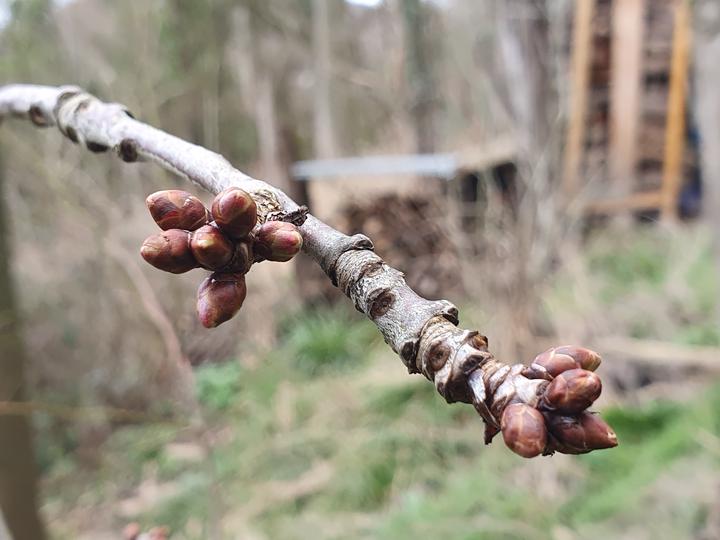New publication - Apparent differences in agroclimatic requirements for sweet cherry across climatic settings reveal shortcomings in common phenology models

Temperate fruit trees such as apples, cherries or apricots lose their leaves and fall dormant in winter. To come back to life in spring, they must first experience cold temperatures and, after they have fulfilled their chilling requirements, they need warm conditions to develop leaves and flowers.
How much chill and heat the trees require is commonly believed to be genetically determined. This means that each tree cultivar should have specific chill and heat requirements, which are more or less fixed and independent of where the trees are grown. To find out if this is really true, a comparison of temperature responses of the same cultivars in different places may produce interesting insights.
In a recent paper published in Agricultural and Forest Meteorology (Fadon et al., 2023), an author team led by former HortiBonn scientist Erica Fadon (now working with Javier Rodrigo in Zaragoza) and involving three more HortiBonn team members (Hoa Do, Michael Blanke and Eike Luedeling), compared temperature responses of three sweet cherry cultivars grown under contrasting conditions in Zaragoza, Spain and Bonn, Germany.
The team used a statistical technique, Partial Least Squares (PLS) regression, to evaluate long-term records of cherry bloom for the cultivars ‘Burlat’, ‘Samba’ and ‘Sylvia’, for which datasets were available for both locations.
Initial plans to combine records from both places into one analysis did not produce useful results, so the team looked at bloom data for each location separately and compared the results.
Chill and heat requirements across locations
In the relatively cold climate of Bonn, trees were exposed to lots of chill, which made them very responsive to spring warming. Zaragoza presented an opposite scenario, with relatively little chill in winter and abundant warmth in the following spring. These contrasting conditions led to considerable differences in estimated agroclimatic requirements.
In Bonn, the three cherry cultivars needed 87-105 Chill Portions (CP) and 3233-4343 Growing Degree Hours (GDH) to bloom. In Zaragoza, in contrast, the trees needed only 48-59 CP but 5444-6988 GDH for the first flowers to appear. For trees in Bonn, available heat in spring appeared to be the limiting factor, while in Zaragoza, bloom dates were mainly influenced by variation in winter chill.
Such differences in chill and heat requirements are difficult to reconcile with the idea that these requirements are the same regardless of where trees are grown.
Unreliable metrics
Results from this analysis clearly imply that chill and heat requirements of tree species may not be quite as genetically fixed as is often assumed. It is also possible, however, that the discrepancy in chill and heat requirement estimates arises from the poor quality of available chill and heat models. Scientists have developed a number of such models over the past 100 years or so, but these models respond to temperature in very different ways, implying that they can’t all be correct. This is partly because progression through dormancy is hard to observe - tree buds look pretty much the same throughout the winter - which makes developing reliable models quite difficult. Given this uncertainty about how reliable the models are, it is quite difficult to interpret the findings of such a study.
General insights
The study showed that combining bloom and temperature data from different locations and using them to determine chill and heat requirements using PLS regression doesn’t work very well, at least when locations are as different as Zaragoza and Bonn. The analysis also showed that, when using the commonly applied models to quantify chill and heat requirements, the climatic needs of the trees can vary widely between locations. It seems likely that the doubtful quality of the models contributes to these differences, but there may also be a true dependence of agroclimatic needs on the climatic conditions of a particular site. This contradicts the commonly held believe that these requirements are genetically determined and don’t vary according to the growing region.
The main conclusion from this work is the need for a process-based methodology to determine chill and heat requirement, to replace the purely statistical PLS regression procedure. A major reason why PLS regression failed is that the different stages of the dormancy period don’t happen at the same time in the two locations. This is a problem for this statistical procedure. A process-based approach that simulates the physiological responses of trees to temperatures experienced during dormancy may be able to overcome this problem.
The PhenoFlex framework (Luedeling et al., 2021), which has recently been developed by the HortiBonn team, offers opportunities for substantial improvements in modeling the phenology response of temperate trees. Watch this space for new developments along this line of work.
Reference:
Fadon, E., Do, H., Blanke, M., Rodrigo, J., Luedeling, E., 2023. Apparent Differences in Agroclimatic Requirements for Sweet Cherry Across Climatic Settings Reveal Shortcomings in Common Phenology Models. Agric. For. Meteorol. 333, 109387. https://doi.org/10.1016/j.agrformet.2023.109387
Luedeling, E., Schiffers, K., Fohrmann, T., Urbach, C., 2021. PhenoFlex - an integrated model to predict spring phenology in temperate fruit trees. Agric. For. Meteorol. 307, 108491. https://doi.org/10.1016/j.agrformet.2021.108491